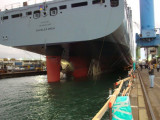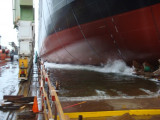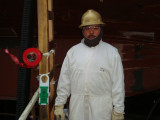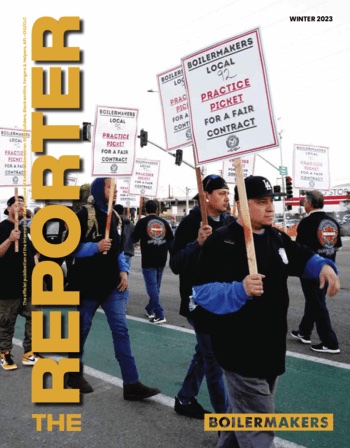L-1998 member Robert Navarro uses a crane to position the “ways” (the launch ramp) for the USNS Charles Drew.
View Photo Gallery (5 photos)
Navy awards additional contract, guaranteeing work through 2012
MEMBERS OF LOCAL 1998 (National City, Calif.) witnessed the successful launching of the USNS Charles Drew Feb. 27. It was the 10th in a series of 12 ships the members are building; the remaining two are in various stages of construction at the San Diego shipyard. But the best news of the day quickly followed: The Navy was awarding them another contract to increase the total number of ships to 14, guaranteeing them steady work through 2012.
The series began in 2001 when the U.S. Navy awarded the National Steel and Shipbuilding Company (NASSCO), a subsidiary of General Dynamics, with a $709- million contract to design and build the first two ships in the T-AKE program. T-AKE vessels are a new class of combat logistics force ships. The award included options exercisable by the Navy for 10 additional ships over the next six years, for a potential contract value of $3.7 billion.
Those options were increased this February, when NASSCO received an $825 million contract for T-AKE 13 and 14, bringing the total contract value to about $5.2 billion. This additional funding gives NASSCO a firm backlog of shipbuilding through 2012.
The T-AKE class is a dry cargo/ammunition ship measuring nearly 700 feet in length, with berthing, messing, and leisure and community spaces for nearly 200 military and civilian personnel. These ships provide logistic lift from sources of supply either in port or at sea. They transfer such cargo as ammunition, food, fuel, repair parts, and expendable supplies and material to station ships and other naval warfare forces at sea. The T-AKE will replace the aging T-AE ammunition ships and T-AFS combat stores ships that are nearing the end of their service lives.
The T-AKE-10 is named in honor of Dr. Charles R. Drew (1904–1950), who developed improved techniques for blood storage and applied his expert knowledge in developing large-scale blood banks early in World War II, saving thousands of Allied lives.
According to John Chapman, Asst. Director of the Boilermakers Industrial Sector Operations, Local 1998 represents about 1,900 of the 2,400 workers at the shipyard. Other bargaining units include Steelworkers, Carpenters, Painters, Teamsters, and Operating Engineers.











